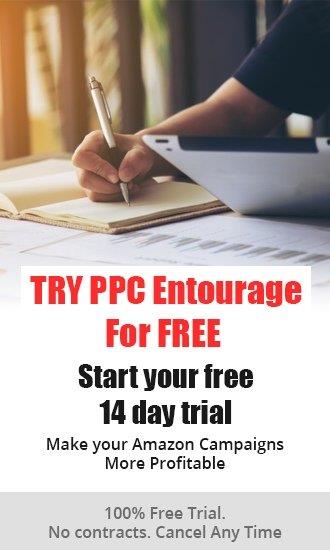When looking at the different types of Amazon ads for campaigns, sellers have a variety of ad formats (Sponsored Products, Sponsored Brands, Sponsored Display) and placements to choose from.
The question becomes which type of ad should a seller use in order to increase/maximize sales, while minimizing campaign Ad Spend and lowering ACoS. Exploring the attributes of each ad type can help to understand how Amazon advertising works and break down the distinctions between each ad format to provide an insightful answer.
Types of Amazon Ads
Amazon Sponsored Product Ads
These are pay-per-click advertising campaigns, that use keyword and product targeting to advertise individual products. With Sponsored Product Ads, sellers can manually or automatically target keywords relevant to their target audiences. If a seller utilizes automatic keyword targeting, Amazon determines and targets the most relevant keywords for his or her products.
Sellers have the option of choosing from Exact, Phrase, or Broad match types. Sellers can also set a daily budget, as well as the campaign duration. The campaign can be paused at any time, but it must run for at least 1 day.
Due to their prime location in search results, Sponsored Product Ads help Amazon sellers to attract their target audiences. They also influence online shoppers in the later phrases of the Customer Buying Cycle to purchase their products.
Amazon Sponsored Products Ads appear on mobile and desktop devices.
Sponsored Products ads may appear at the top of, alongside, or within search results and on product detail pages. Ads perform differently depending on where they show up.
Top of Search yields high conversion and click-through rates, when compared to Rest of Search. When compared to Top of Search, the product detail pages have much lower conversion and click-through rates. However, Impression share, visibility, and Reach will be much higher on the product detail pages.
Reach refers to the total number of people who have seen your ad. Reach can help sellers to determine whether there’s something wrong with their ads. For example, if a seller's ads have reached a lot of online shoppers but those ads haven’t had a single conversion, that might mean the seller has to revise the content of the ad to better focus on a specific target audience.
Also, when sellers know how many online shoppers their ads might reach, they are able to make smarter decisions about where to direct their Ad Spend budgets.
Pro Tip: Use Negative Keywords to reduce the drain on your Ad Spend budget for your Sponsored Products campaigns. Negative keywords permit sellers to refine and mold their target audiences in order to improve the performance of their Sponsored Products campaigns.
Amazon Sponsored Brand Ads
Sponsored Brands Ads, (formerly known as Headline Search ads) are pay-per-click ads that use keyword targeting. Instead of advertising one product at a time like Sponsored Products ads, they have the ability to spotlight three or more different products at the same time.
Sellers can use keywords across all three different match types: Exact, Phrase, and Broad. Amazon also provides suggested keywords for bidding based on the seller’s product and product information.
This type of Amazon ad also features Automatic and Manual bidding. With automatic bidding, Amazon optimizes the seller’s bids automatically, but only by lowering them, it never increases the seller’s bids.
Sellers can drive brand awareness and sales, plus promote multiple new products at once. In addition, sellers can create a custom landing page (customizable headlines, images, logos).
Amazon Sponsored Brand ads appear at the very top of a search results page, to the left of search results and above all organic listings and Sponsored Product ads. They can also show up in Rest of Search (near bottom of the page). It is possible for them to appear on product detail pages (only Sponsored Brands ads that are linked to a store are eligible to appear for this placement).
Pro Tip: Click-through rates provide sellers with information on how well their ads are matching with customer interest as indicated by their search. A strong click-through rate indicates that keywords and creative are well matched and customers find them compelling enough to click through and learn more about a seller's products and brand.
Sponsored Brands Store Spotlight ads
Store Spotlight ads are a mobile only ad type, that drives traffic to a brand store and/or subpages of that store. Sellers have the ability to select which pages they would like to highlight and drive traffic to.
Usually, a Sponsored Brands campaign features a logo, headline, and up to three products. Rather than products, this format spotlights a brand’s Amazon Store (up to three sub-pages), helping online shoppers to discover the different product categories available more easily within the seller’s Store.
The Store sub-page selection gives the online shopper a good idea of a brand’s catalog without the need to click around. It also lets the shopper click to the exact sub-page they want to browse, making for a more streamlined experience.
When setting up a Store Spotlight campaign, Amazon will automatically pull three Store sub-pages into the creative. These sub-pages can be changed, as well as the image that features them. Like the classic Sponsored Brands layout, these campaigns have customizable headlines, images, logos, and permit product/ASIN targeting as well as negative targeting of products/ASINs.
Sponsored Brands Video ads
Sponsored Brands Video ads can be used by sellers to stand out in desktop and mobile shopping results in order to help online shoppers discover their brands and products as they shop on Amazon.
Video ads are keyword targeted, cost-per-click, and link online shoppers directly to the product detail page where they can learn more and purchase.
It is recommended that the product is in plain sight within the first second of the video, because the video will play automatically when at least 50% of it is on the screen at the top of search, catching the online shopper’s immediate attention.
All Sponsored Brands video campaigns are subject to Amazon’s sponsored ads creative acceptance policies. All content must be appropriate for a general audience and must comply with all laws, rules, and regulations that apply to the seller or the advertising content in any location where the advertisements may appear. Ads that do not meet these policies will not be accepted for Sponsored Brands video.
Amazon Sponsored Display Ads
Sponsored Display ads appear in different locations and they are designed to reach relevant audiences who browse, search, or purchase products on and off Amazon. They are used to market products directly at the point of sale (e.g. below the Buy Box or bullet points on detail pages).
Amazon shows a seller’s promoted products to online shoppers who have viewed their product detail pages or the detail pages of similar products in the last 30 days. This excludes online shoppers who are unlikely to purchase a seller’s products (such as those who have recently purchased a similar product).
Sponsored Display ads target a seller’s potential customers by their behavior.
These prospects…
- are looking at product categories that the seller’s products fall under
- are looking at categories related to the category the seller’s products are in
- are looking at listings featuring products similar to the seller’s
- have previously bought products in the same category or a category related to the seller’s products
- have previously viewed the seller’s products
- have previously bought the seller’s products
They run across desktop, mobile, and mobile app.
Like Sponsored Product ads or Sponsored Brands ads, Sponsored Display ads are PPC (pay-per-click) campaigns. Sellers are only charged when an online shopper clicks their ad. Amazon will adjust a seller’s bid up or down depending on the likelihood of a conversion.
Sponsored Display ads give sellers a bit more control over the ad creative. Sellers can add in their brand logo and a custom headline. These ads also have the highest amount of real estate available on Amazon. Ads can appear on a product’s detail page, on the right rail of search results page, on the bottom of the search results page, on customer review pages, at the top of offer listing page, or in Amazon-generated marketing emails.
Pro Tip: Sponsored Display Ads can also be used to highlight additional products that can be bundled by online shoppers. Use your Brand Analytic reports (Market Basket Analysis) to identify your popular selling products that complement each other. Target those ASINs so that they show up together, taking up valuable space on your listing, protecting it from competitors with similar products. Doing so will open opportunities for cross-selling or upselling, while increasing the average cart value.
Amazon plans to continually test new placements and features for these types of Amazon ads.
It's vital that every seller stay current on where their ads show up and how best to use them as part of a larger/on-going Amazon advertising strategy…a strategy that quickly adapts to the latest changes and trends within the Amazon platform.
If you are unsure as to how to obtain the maximum ROI from your Amazon advertising campaigns, our team of experienced experts can work with you to achieve your goals.
Entourage Management Services has opened applications. We can also manage your entire brand’s Amazon advertising, with no limits to number of products, countries, or ad types.
Click here to learn more about Entourage Management Services and to apply











